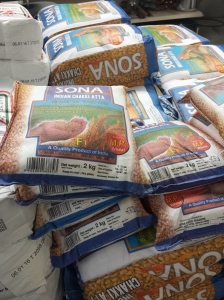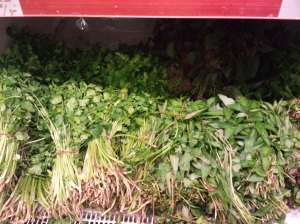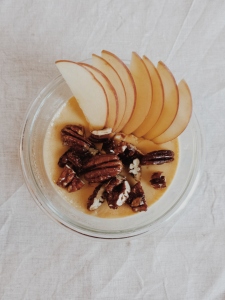Today was wonderful. I cooked and ate all day. I found Burrata (!) at my farmer’s market, which was definitely a highlight. I ate some home-grown white asparagus, from my cleaning lady’s garden, baked a pie, and ate this fabulous salad for dinner. The whole of May up until a few days ago have been so stressful. I had so much work, which doesn’t get easier even if you have one or two free day(s) a week, and if you commute half the time to a city that is 100km away. Anyways, the weather finally turned warm this week, and I was home all day today, planned to do absolutely nothing. The farmer’s market in Leipzig was bursting with strawberries, white asparagus, cherries, and other early summer goodies. I bought a bunch of mint, coriander, and thai basil a few days ago. I have… ehem… thrown out more than a few shares of leftover herbs in my life. I would buy these three herbs mentioned above for a vietnamese or thai feast, then forget about them, and find them in inedible state a week later in my crisper box. Yeah… It’s not something I’m proud of. So today, I have decided to use up all the leftover herbs for a scrumptious bowl of summer salad. A very large handful of these herbs went in a small food processor with coconut milk, lime juice, green chili, ginger, spring onion and etc. You can use any kind of vegetables to you liking, and thin rice noodles would also work in place of vermicelli.
Vermicelli Salad with Green Coconut Dressing
Serves two
For the dressing,
1 large spring onion, sliced finely
1 thumbnail sized ginger, chopped finely
2 cloves garlic
1 Tbsp vegetable oil
A very large handful mixture of coriander, thai basil, and mint leaves
Juice of 1/2 lime
3.5 Tbsp coconut milk
2-3 dashes fish sauce
1-2 tsp soy sauce
1/2-1 medium hot green chili
1. To make the dressing, sautee sliced spring onion, ginger, and garlic with oil over medium-high heat. Once they start to soften, transfer to a food processor. Add the rest of the ingredients. Blend until smooth. Adjust the acidity and seasoning to your likings.
For the salad, (like I said, this is only an example. Add anything you like to the salad bowl)
50g vermicelli, soaked according to package instruction
Lettuce leaves
Handful radishes and greens, sliced and chopped finely
Cucumber, finely sliced
Zucchini, julienned
Avocado, broken into small chunks
Enoki mushrooms



















